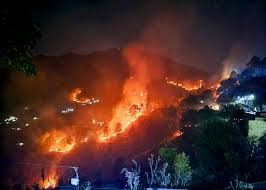Overview:

Massive forest fires are currently affecting various parts of Uttarakhand, with nearly 100 hectares of woodland already burned. These fires have been intensified by a prolonged heatwave and extremely dry conditions.
In certain affected zones, helicopters equipped with Bambi buckets—a specialized aerial firefighting device—have been deployed to deliver water directly onto the flames.
Uttarakhand frequently experiences forest fires due to unfavorable weather patterns, including extended heat and dryness. Contributing factors also include the accumulation of dry pine needles and human-induced causes, such as setting fires to clear land for new grass or improper disposal of cigarettes.
Roughly 36% of India’s forested regions are considered highly susceptible to recurring fires.
To combat this issue, the government has introduced several measures like the National Action Plan on Forest Fires (2018), the State of Forest Report (2021), and the Van Agni Geo-portal by the Forest Survey of India. Legal frameworks like the Wildlife (Protection) Act, 1972, strictly forbid igniting fires within wildlife sanctuaries. Prevention strategies include setting up watch towers for early detection, engaging local communities in fire management, and establishing fire lines to control the spread.




